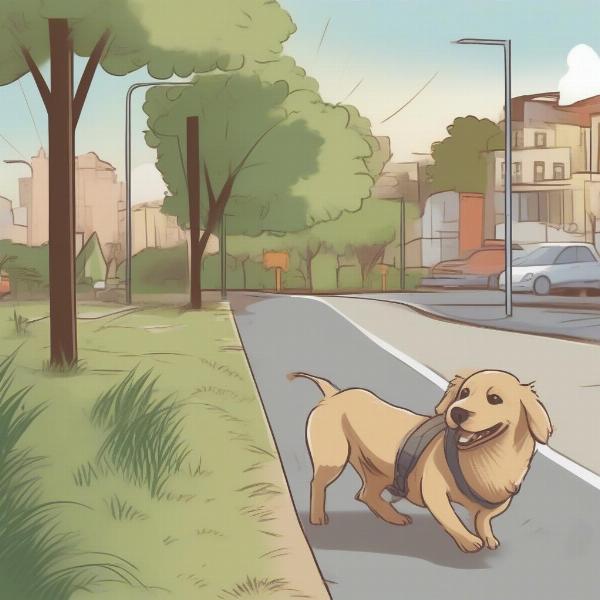Dog ownership is a rewarding experience, but it’s crucial to be aware of the potential dangers that can threaten your furry friend’s well-being. From everyday household items to environmental hazards, understanding these risks is essential for responsible pet ownership. This article will explore various dog dangers, providing practical advice and tips to help you create a safe and secure environment for your beloved companion.
Common Household Dangers for Dogs
Many seemingly harmless items in our homes can pose significant risks to dogs. These include:
- Toxic Foods: Certain foods that are safe for humans can be toxic to dogs. Chocolate, grapes, raisins, onions, garlic, xylitol (artificial sweetener), and macadamia nuts are just a few examples. Keep these foods out of your dog’s reach.
- Cleaning Products: Many household cleaners contain chemicals that can irritate a dog’s skin, eyes, and respiratory system. Store cleaning supplies securely and ensure proper ventilation when using them.
- Medications: Human medications, even over-the-counter ones, can be extremely dangerous for dogs. Never give your dog any medication without consulting your veterinarian.
- Electrical Cords and Wires: Chewing on electrical cords can cause burns, electric shock, and even death. Conceal or cover exposed wires and provide chew toys to redirect your dog’s attention.
- Small Objects: Dogs, especially puppies, tend to explore the world with their mouths. Small objects like buttons, coins, and toys with small parts can be choking hazards.
Environmental Dog Dangers
Beyond the home, various environmental factors can pose a threat to dogs:
- Traffic: Keep your dog on a leash when walking near roads and ensure they understand basic obedience commands like “stay” and “come.”
- Wild Animals: Encounters with wild animals, such as skunks, raccoons, and snakes, can result in injuries or the transmission of diseases. Supervise your dog when outdoors, especially in areas where wildlife is prevalent.
- Plants: Many common garden plants, like lilies and azaleas, are toxic to dogs. Research pet-friendly plants and keep toxic ones out of your dog’s reach.
- Pesticides and Herbicides: These chemicals can be harmful if ingested or absorbed through the skin. Keep your dog away from treated areas until they are dry and follow the manufacturer’s instructions carefully.
- Extreme Weather: Dogs are susceptible to heatstroke and hypothermia. Provide adequate shelter and fresh water, especially during hot or cold weather.
 Environmental Dog Dangers: Traffic, wild animals, toxic plants, and extreme weather.
Environmental Dog Dangers: Traffic, wild animals, toxic plants, and extreme weather.
Recognizing Signs of Danger in Your Dog
It’s crucial to be able to recognize signs that your dog might be in danger. These include:
- Difficulty breathing
- Vomiting or diarrhea
- Lethargy or weakness
- Seizures
- Loss of coordination
- Excessive drooling
- Pale gums
If your dog exhibits any of these signs, contact your veterinarian immediately.
What should I do if my dog ingests something poisonous?
If you suspect your dog has ingested something poisonous, contact your veterinarian or a pet poison control center immediately. Time is of the essence.
How can I prevent my dog from chewing on electrical cords?
Cover exposed cords with cord protectors or use bitter apple spray to deter chewing. Provide plenty of appropriate chew toys to redirect your dog’s attention.
Conclusion
Keeping your dog safe requires vigilance and awareness of potential dangers. By taking proactive steps to create a safe environment and understanding the signs of distress, you can help your canine companion live a long, healthy, and happy life. Remember to consult with your veterinarian for personalized advice and guidance.
FAQ
- What are the most common household dangers for dogs? Toxic foods, cleaning products, medications, electrical cords, and small objects are common household hazards.
- What are some environmental dangers for dogs? Traffic, wild animals, toxic plants, pesticides, and extreme weather can pose risks to dogs.
- What should I do if my dog eats something toxic? Contact your veterinarian or a pet poison control center immediately.
- How can I make my home safer for my dog? Secure toxic substances, cover electrical cords, and provide appropriate chew toys.
- How can I protect my dog from environmental dangers? Keep your dog on a leash, supervise them outdoors, and be aware of potential hazards like traffic and wildlife.
- What are the signs that my dog may have ingested something poisonous? Signs include vomiting, diarrhea, lethargy, seizures, difficulty breathing, and changes in behavior.
- Where can I find more information about dog safety? Your veterinarian, animal shelters, and reputable online resources can provide valuable information.
ILM Dog is a leading international online resource dedicated to providing dog owners with expert advice and information on all aspects of dog care, from breed selection and puppy care to senior dog care and travel tips. We offer practical guidance on dog health, training, nutrition, grooming, and much more. Our goal is to empower dog owners with the knowledge they need to provide their beloved companions with the best possible care. For any inquiries, contact us at [email protected] or call us at +44 20-3965-8624. Visit ILM Dog for more valuable resources and expert advice.